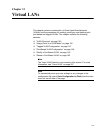
Chapter 13: Virtual LANs
150
VLAN Overview
A virtual LAN or VLAN is a group of ports on an Ethernet switch that form
a logical Ethernet segment via the AT-S111 Management software. The
ports of a VLAN form an independent traffic domain where the traffic
generated by the nodes of a VLAN remains within the VLAN.
With VLANs, you can segment your local area network using the AT-
S111’s Management software and group nodes with related functions into
their own separate, logical, VLAN segments. These VLAN groupings can
be based on similar data needs or security requirements. For example,
you can create separate VLANs for each department in your company,
such as Sales, Accounting and Engineering.
VLANs offer several important benefits:
Improved network performance
Network performance often suffers as networks grow in size and as
data traffic increases. The more nodes on each LAN segment vying for
bandwidth, the greater the likelihood overall network performance
decreases.
VLANs improve network performance because traffic stays within the
separate, logical LAN segment of the VLAN. The nodes of a VLAN
receive traffic only from nodes of the same VLAN. This reduces the
need for nodes to handle traffic that is not destined for them. It also
frees up bandwidth within all the logical workgroups.
In addition, because each VLAN constitutes a separate broadcast
domain, broadcast traffic remains within the VLAN and is not shared
with other ports of the switch that are not members of that VLAN.
Because the broadcast traffic is not shared with ports outside of the
VLAN, those non-member ports experience an overall network
performance improvement.
Increased security
Because data traffic generated by a node in a VLAN is restricted only
to the other nodes of the same VLAN, you can use VLANs to control
the flow of packets in your network and prevent packets from being
shared with unauthorized end nodes.
Simplified network management
VLANs can simplify network management. Before VLANs became a
layer 2 feature, physical changes to the network often had to been
made at the switches in the wiring closets. For example, if an
employee changed departments, changing the employee’s LAN
segment assignment might require a change to the cabling of the
switches.


















